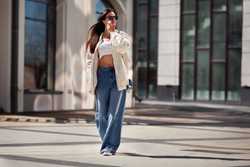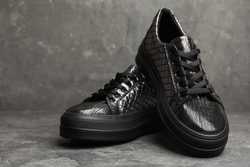- Sizes: S-XXL
- Colors: Black, alder, twilight
- Material: 100% recycled polyester shell, ThermaFill synthetic fill
- Price at time of publish: $139.30
10 Best Winter Jackets and Coats for Men in 2024: Look Cool, Stay Warm

Our evaluations and opinions are not influenced by our advertising relationships, but we may earn a commission from our partners’ links. This content is created by TIME Stamped, under TIME’s direction and produced in accordance with TIME’s editorial guidelines and overseen by TIME’s editorial staff. Learn more about it.
When you live in one of the colder states, style often—and understandably—takes a back seat to simply maintaining a functional temperature. But if your current winter coat leaves you unable to even put your arms down by your sides (“It’s Gore-tex, Jerry!”) then it might be time to look at some other options. We’ve rounded up the best winter jackets and coats for men, whether you’re the type of person who likes a lighter weight coat to layer over a hoodie or sweater, or want the absolute warmest outerwear.

It’s no good spending all your budget on a winter coat, only to find you can’t afford to leave the house anymore. This suggestion from Straughan is certainly more affordable than many, without sacrificing quality—and from a brand known for quality and warmth. (Eddie Bauer made our list of the best flannel shirts and best flannel sheets.) “This insulated parka from Eddie Bauer is a good, affordable choice right now,” she says. “It’s hard to find a jacket that will be waterproof and insulated for under $100—this one is reportedly warm for temperatures just below freezing, making it a comfortable, everyday winter coat.”
An affordable, hooded coat that’ll keep the rain off, and boasts pockets to spare.
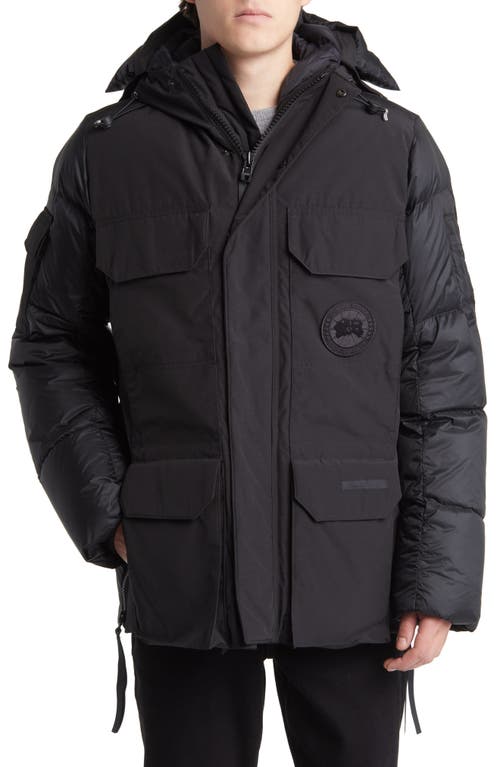
Warmest doesn’t necessarily mean most expensive, but warm and stylish as hell? Yeah, that’s going to cost you. “Is this a splurge? Yes,” admits Fratto. “However, when you’re looking for a stylish and warm down coat, you can’t beat the Paradigm Expedition Parka from Canada Goose. This is a new styling of a tried and true classic that the brand has tested to keep you warm even in the most extreme temperatures.” It’s probably the one coat that both complements yet elevates even something as basic as sweatpants.
An awesomely stylish and warm coat that looks simply incredible in white.
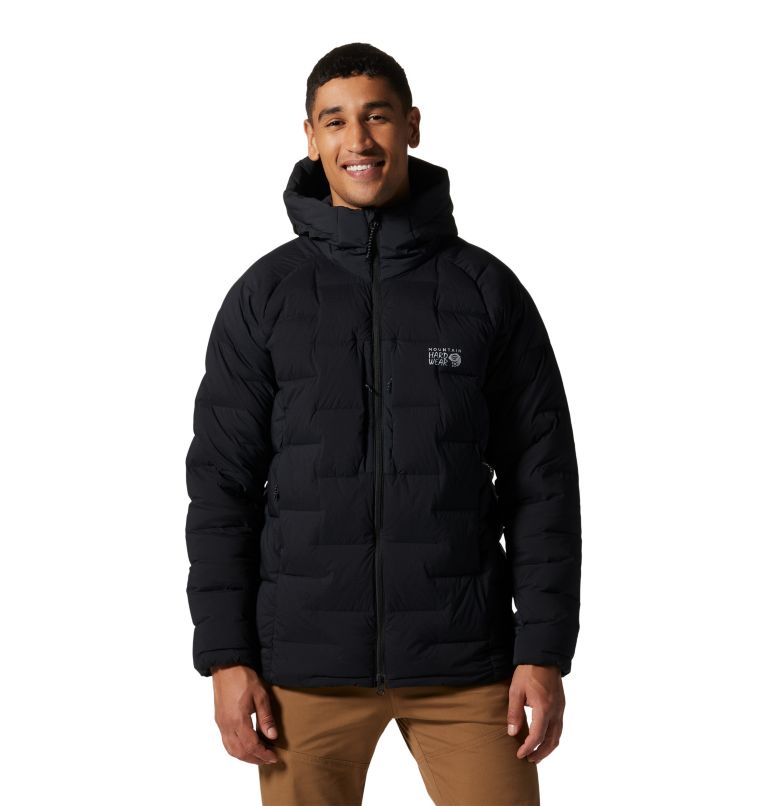
Classics are classic for a reason, and it doesn’t get much more classic on a cold day than the familiar, bumpy silhouette of a puffer jacket. Dimitry Loiseau, founder and chief editor of REGARD magazine, recommends this option from Mountain Hardwear, saying, “The fabric and design for this jacket is next level. It has the most unbelievable stretch, so it’s so easy and comfortable to wear, while remaining extremely functional.”
A classically-styled puffer jacket made from modern, cold-beating materials.

“Parkas are some of the warmest types of winter jackets, so they tend to come at a higher price point,” says Straughan. “This choice from Patagonia features a durable shell made of Gore-tex recycled material, and insulation from 100% recycled goose and duck-down material. It’s a heavy-weight jacket (41.7 ounces) and has 700-fill-power down, which will be sure to keep you warm.”
A tough, functional parka that’ll keep the weather out and the warmth in.

If you’re looking for something that’ll get the job done without all the extra design fripperies, look no further. “With solid technology and minimal styling, the Therme Parka from Arc’teryx is an easy choice when you're looking for a performance winter coat,” says Fratto. “The blend of synthetic, yet breathable fabrics and natural fillers makes this water and windproof coat a top choice all around.”
A straightforward, intensely practical winter coat for those whose primary concern is keeping warm and dry.

Both Fratto and Loiseau advise taking a look at Patagonia’s aptly-named Nano Puff, if you’re looking for something a little smaller. “It has all the Patagonia quality in a lightweight, easy-to-wear jacket, making it a staple for transitional seasons as well,” says Fratto. Loiseau adds that, “It's great because you can throw it in a bag easily and bring it everywhere with you. I also love that it's adjustable!”
A lightweight, versatile jacket with a ton of color choices that zips up neatly into its own carrying pocket.

Depending where you live, warmth is only one part of the equation when it comes to a winter coat, with the other major one being, does it keep you dry? It’s for the latter aspect that Loiseau recommends this jacket, which is waterproof, warm, and moisture-wicking. “It’s also breathable and insulated,” adds Loiseau. “Get this jacket in your wardrobe and you’re ready to face the rain!”
A practical option for wet, wintry weather.

When the weather outside makes your skin sting and icicles form on your eyelashes, you need something truly special to keep out the cold. Originally designed for a climber planning to scale Mount Everest, this is a highly technical jacket that still allows for a surprising range of movement. “The Tindur Down Jacket boasts impeccable performance thanks in part to its commitment to construction,” says Fratto. “It takes a full two days to sew a single jacket and in production time, that tells you that no corners are cut and quality is top of mind.”
A serious winter coat for serious climates.
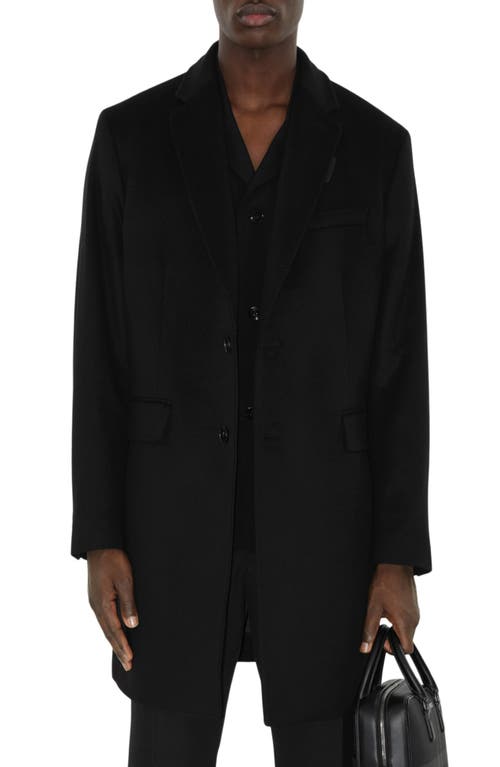
Not all winter coats have to be up to the task of scaling a mountain, of course—some just need to look beautiful while keeping out the chill, and this coat very much falls into the latter camp. “When I think of classic and timeless winter coat styling, my mind instantly goes to British tailoring, and what better brand to showcase this than Burberry?” remarks Fratto. “Refined and impeccably designed, this wool and cashmere tailored coat speaks volumes without saying a single word.”
Not the most practical or affordable winter coat, but if you’re going for style, this is it.

“A winter coat option on Amazon with overwhelmingly positive reviews is this one from Columbia,” says Straughan. “The jacket is a mix of polyester and nylon materials, features a hood, and is climate pledge friendly, indicating that it’s made from synthetic down instead of animal materials. It has a sleek style for everyday wear, or even for outdoor activities such as skiing and hiking.”
A practical, affordable winter coat with a variety of color choices.
Our picks were made with the input of our panel of style and clothing experts, who know the fashion industry—and the world of winter coats—inside out. We also considered price, materials, and style, and ensured all of our picks were highly rated by actual customers.
As when buying other cold weather items, you want to take functionality into account in addition to what it looks like. For example:
“When looking at material for a winter jacket for men, you want to compare both the outer shell and insulation,” says Jennifer Straughan, owner of The Thrifty Dresser. “The outer shell needs to be waterproof and have some element of wind-breaking to be effective in keeping warmth inside the jacket. However, suppose you live somewhere that experiences multiple different climates. In that case, it can be helpful to have removable layers incorporated into your winter jacket, like a fleece insert or removable windbreaker.”
“The outer part of the jacket will likely be made from either nylon or another synthetic material, that’s both water-resistant and tightly woven to prevent wind air from infiltrating,” says Straughan. “The inside of the jacket is made from bird down or synthetic material. Down fill-power is one measure you can consider for determining the warmth of a winter coat: Usually, the down power is somewhere between 400-1,000, with 1,000 being the most lofty and providing the most warmth, but also, the most expensive insulation. Only those facing extreme arctic climates will need fill power that high.”
Straughan adds that fill weight is another important consideration, i.e., the total amount of down in the jacket. The higher the weight, the warmer the coat. “If you mainly need warmth, you’re likely looking for a three to six ounce down jacket with a fill power of 800+,” she says.
“First and foremost, buy quality,” advises Patrick Burch, co-owner of Cave + Post Trading Co. men’s boutique. “It’s either going to be a ‘daily driver’ and therefore you want it to wear well, or it’s going to be a fashion piece that you’ll only wear a couple times a year, but that you want to last forever. Therefore, quality is first.”
“Are you the classic gentleman who dons meticulously tailored overcoats and keeps it traditional and sophisticated?” asks Charles Fratto, style director for ILOE Studios. “Or are you a fashion risk taker who’s always willing to push the style envelope and experiment with textures, hardware details, and silhouette? Or are you possibly the outdoorsy type who values performance wear for cold weather adventures? Everyone will answer these questions differently and by simply taking a small amount of time to answer them, it will make the overall buying experience easier, faster, and a lot more fun.”
“Brands that use down insulation are the warmest,” affirms Straughan. “Downs taken from ducks or geese are from animals sourced and used for food, so they’re not hunted strictly for their downs. However, many still have ethical concerns with this practice.
Brands such as Canada Goose, 66 degrees North, and Moose Knuckles use either goose or duck down as insulation. Other brands, such as The North Face, also use lofty goose down for insulation, but again, only from birds that are otherwise sourced for the food industry.”
Straughan advises that several brands use a synthetic insulation called PrimaLoft instead, so if that’s important to you, you might want to check out coats from Patagonia and Lululemon. “The general consensus is that synthetic down will not provide the same warmth as bird down, although it is a good alternative, especially if you’re completing performance activities outside that require some breathability,” she says.
Straughan suggests looking at The North Face, Patagonia, Lululemon, TenTree, Eddie Bauer, and Columbia. Burch, meanwhile, recommends Filson, which he says, “has been a mainstay of stylish, outdoor goods since 1897. You’ll see their pieces all over the Yellowstone show and on real ranches worldwide. It’s a heritage brand, with quality materials and construction, beautiful fabrics, and durability.”
“The weight, the material it’s made from, and the price all can be indicators of a jacket's quality,” says Straughan. “However, not all quality winter jackets look the same–some wool and cashmere coats can also be good options, depending on what you’re looking for. Each of those is made of high-quality materials, just not as water-resistant.”
“With winter jackets in particular, you need to walk that fine line of finding a piece with the perfect amount of ease,” says Fratto. “The chances of you wearing additional layers underneath it are pretty much guaranteed, so err on the side of more ease rather than less. But don’t go overboard lest you look like you’re drowning in fabric—that’s never a good look and it will be unpleasant to wear. You want the jacket to compliment your silhouette, not distract from it one way or the other.”
“A good winter coat will likely start around the $100 price point, and go up from there,” says Straughan. “Outerwear is not cheap, so consider shopping second-hand to find quality products at a lower price (and to be more sustainable!) A great part about winter clothes is that in many climates, people only need them half the year, so people tend to sell and donate older clothes that are still in excellent condition due to their quality construction.”
“It all depends on what you’re wearing the coat for,” adds Loiseau. “If you’re working in Alaska or anywhere near the north pole, you don’t want to sacrifice on price, as it can mean your life. However, when it comes to fashion, there’s a little more wiggle room for your budget. Plus, think about how often you’ll wear it and if you’re going for one staple, go-to jacket, or will be getting different jackets for different occasions.”
The information presented here is created by TIME Stamped and overseen by TIME editorial staff. To learn more, see our About Us page.

